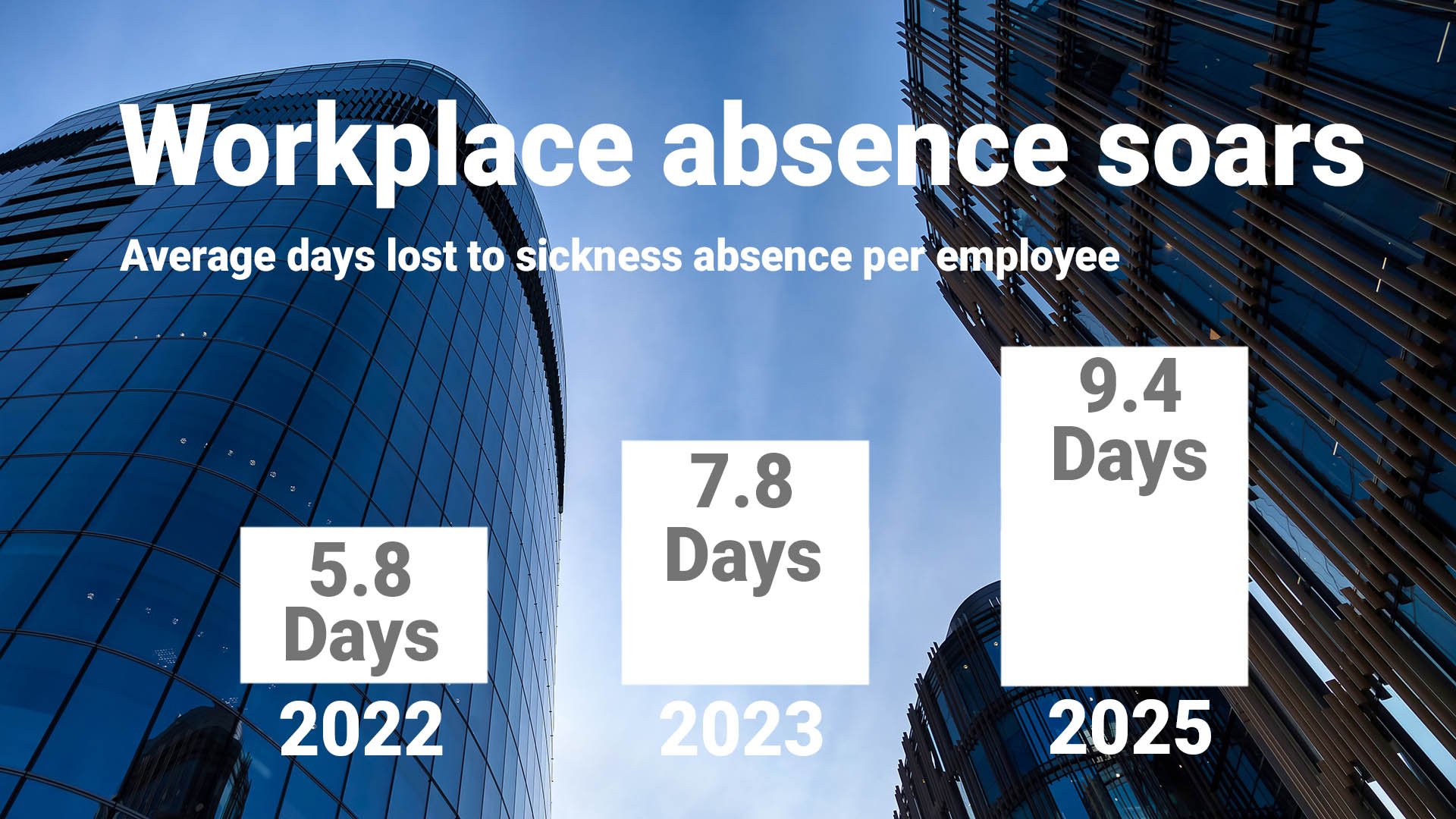UK sickness absence at record high
CIPD warns rising absence, mental health strain and budget pressures are putting UK workforce wellbeing under growing strain.
Sickness absence in UK workplaces has reached its highest level in over 15 years, according to the CIPD’s 2025 Health and Wellbeing at Work report. The survey of more than 1,100 organisations finds employees are now taking an average of 9.4 days off per year, up from 7.8 in 2023 and 5.8 in 2022.
The CIPD warns that the figures point to a workforce health crisis, with mental ill health, stress and musculoskeletal conditions driving much of the increase. More employers are putting wellbeing strategies in place, yet rising costs and unequal access to workplace healthcare are hampering progress.
Mental health pressures intensify
Mental ill health is now the leading cause of long-term absence (41% of employers cite it in their top three causes) and the second most common cause of short-term absence. Stress is also a high factor, contributing to short and long-term sickness absence.
The survey shows 64% of employers reported stress-related absence in the past year, rising to 84% in the public sector. Heavy workloads stand out as the leading workplace cause, alongside management style and non-work issues such as financial pressures and family concerns.
Despite widespread activity to address stress, only half of organisations believe their efforts are effective.
Wellbeing strategies more common but still reactive
There has been progress: 57% of employers now have a stand-alone wellbeing strategy, up from 44% in 2020. Senior leader commitment has grown: 74% say wellbeing is on the leadership agenda and 75% report line manager buy-in.
Yet, over a third of organisations (37%) remain reactive, acting mainly when employees go off sick rather than putting preventative measures in place.
The CIPD highlights the need for more holistic approaches, combining mental and physical health, good work design, financial wellbeing and support through life stages such as bereavement, menopause, caring responsibilities and chronic illness.
Inequalities in access to workplace healthcare
The report raises concerns about equity in workplace healthcare. Traditional benefit models often exclude lower-paid employees and those with pre-existing conditions, creating barriers for groups already more vulnerable to health problems.
Simplyhealth, which supports the report, argues for affordable, preventative services that ensure all employees, not just those in senior roles, can access timely support including 24/7 GP and mental health services.
Budgets under strain
Although nine in ten organisations (90%) see opportunities from supporting wellbeing, securing budget is the top challenge for 2025, cited by 39% of employers.
The most frequently reported opportunities include:
- Improved employee health and wellbeing (54%)
- Higher engagement (39%)
- Reduced sickness absence (39%)
- Enhanced performance (38%)
Around 29% of organisations expect their wellbeing budgets to increase this year compared with 9% expecting a decrease. The direction of travel is positive but rising costs remain a significant pressure.
Hybrid work: reduced absence, new risks
Home and hybrid working continue to reshape workplace health:
- 36% of employers report sickness absence has fallen due to homeworking, while just 16% report an increase
- Twice as many employers say productivity has risen (33%) as say it has fallen (16%)
But there are risks. Respondents are significantly more likely to report increases in mental health issues among homeworkers than decreases, with only 17% of employers actively monitoring risks for remote staff.
The CIPD cautions that while hybrid work can reduce absence and support rehabilitation, it also demands new management skills to identify and respond to signs of poor wellbeing among dispersed teams.
L&D opportunity: line manager capability still lacking
While the report’s focus is wellbeing, it carries a clear implication for learning and development. Only 29% of organisations train line managers to support staff with mental ill health.
Those that do see significantly better outcomes:
- 73% of trained managers are confident holding sensitive conversations and signposting staff to support, compared with 57% where training is absent
Investment in resilience training and stress management programmes is also reported by some employers, though still in the minority. The findings suggest an important role for L&D in shifting organisations from reactive to preventative wellbeing practices by equipping managers with the right skills.
Line manager training gap
- Only 29% of organisations train line managers in mental health
- Confidence to act: 73% with training vs 57% without
A workforce health turning point
The CIPD concludes that absence levels reflect not just illness but workplace pressures and systemic health challenges. An ageing workforce, the rise in long-term health conditions and widening health inequalities mean employers need to act decisively.
As Rachel Suff, Senior Policy and Practice Adviser at the CIPD, notes in the report:
‘Employers are uniquely positioned to take a preventative approach to health and remove barriers to healthcare access. Investing in wellbeing is not just the right thing to do, it delivers clear organisational benefits.’
With sickness absence at record levels, the case for robust and equitable wellbeing strategies, supported by better-trained line managers, has never been stronger.
Download the report: Health and Wellbeing at Work


